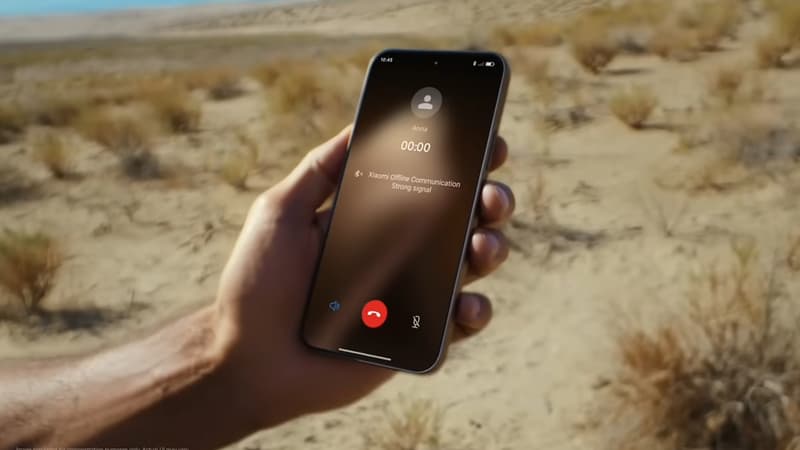A smartphone that can become a super walkie-talkie when you don’t have a network. This is what Xiaomi offers with its latest models, the 15T and 15T Pro. Launched at the end of September, they are equipped with a new technology, called Xiaomi Offline Communication (Offline Communication, in French), which allows voice calls to be made without network coverage (cellular or Wi-Fi) between devices that can be separated by almost two kilometers in the best of cases.
Even more incredible, to connect with each other, the Chinese giant’s smartphones use a Bluetooth connection, although known for its short coverage distance…
Therefore, this function, which could cheer up walkie talkie-loving children or lost and distressed adventurers while walking along isolated trails in the middle of a white area, seems unlikely. Incredible, but true, even, because Xiaomi engineers only did what they said, using Bluetooth… But not just any Bluetooth. Tech&Co explains how it works.
Bluetooth low consumption and very long range…
To begin with, as we have already said, Xiaomi Offline Communication is not based on mobile frequencies, but on Bluetooth. Specifically, it works through Bluetooth Low Energy (BLE), or Bluetooth low energy which, as its name suggests, consumes less energy than the standard version. To be more precise, the 15T and 15T Pro use a very specific version of Bluetooth LE.
Since the introduction of Bluetooth 5.0, a variant of BLE has been introduced, it is called BLE Coded PHY. Designed primarily for the Internet of Things, this is the first time it has been used on a smartphone. Its goal is to transmit data more slowly, but more robustly and over a longer distance (typically varying between 400 and 500 meters, compared to 10 to 100 meters, depending on the environment for standard Bluetooth).
To do this, the data bits are encoded with greater redundancy, explains Xiaomi. This means that additional characters are added compared to the number necessary for the transmission of information, in order to improve its reliability in case of data loss.
Additionally, error coding (FEC) is used and allows the receiver to correct transmission problems without having to retransmit data. Error coding also ensures strong and reliable detection even with a very weak signal, which is obviously essential for establishing a connection between two devices far apart.
Where Xiaomi achieves a feat is that these new smartphones should allow exchanges with a maximum range of 1.3 km for the 15T and 1.9 km for the 15T Pro, according to the Chinese manufacturer. Obviously, this huge increase in range comes with a downside. Throughput (amount of information transmitted in a given time interval) is significantly reduced. It is equivalent to approximately 128 kilobits per second, compared to 1 Mbit/s for the classic standard.
A special chip to the rescue
To guarantee these long-distance connections, Xiaomi uses a chip, called T1S, whose function is to optimize the quality of the wireless connections of the 15T and 15T Pro, whether via Wifi, Bluetooth, 4G/5G or even the GPS signal. In addition to this chip, the Chinese giant has worked on optimizing a network of “super antennas” integrated into its two smartphones, he explains.
These are part of Xiaomi Astral Communication’s “advanced technology package”, which includes Xiaomi Offline Communication. It aims to provide fast, stable and adaptable connectivity in various conditions, Xiaomi said in a statement.
Xiaomi Offline Communication: a conversation similar to a classic call
So, once the BLE encoded PHY connection is established, the smartphone of the user who initiated the call starts recording audio using the Audiorecord tool.
The audio data is then compressed using the open source Speex (compressor-decompressor) codec, before being sent to the other phone, which will decompress it. Once this smartphone has played the audio, that is, the user has heard the message, they can record a voice message and the process will begin again. If this mode of communication is reminiscent of what can be had with a walkie talkie, Xiaomi takes the trouble to specify that for the two interlocutors it will resemble a classic telephone call.
A technology in its infancy… for the moment
At the moment, Xiaomi’s offline communication is quite limited. It only works on 15T and 15T Pro, and requires a Sim card and connection to your Xiaomi account. However, some future smartphones from the Chinese manufacturer should also be compatible with this technology. Talks are also underway to make it available on older models, Xiaomi tells Tech&Co.
Xiaomi’s offline communication is even more limited as it is impossible to make group calls. Exchanges are only allowed between two people. Calls, which will also be encrypted so that only the participants know what is being said.
By default, both interlocutors must be registered in each other’s contacts to be able to chat through Xiaomi technology. However, this setting can be changed to allow calls from anyone. Which will obviously expose you to the risk of receiving calls from little pranksters… if they have a compatible Xiaomi smartphone. Please note that it is currently not possible to block a call made through this technology. The only option will be to dismiss the appeal.
Therefore, Xiaomi still has to move forward, but at a time when other manufacturers, such as Apple, are betting on satellite connection to allow users to send emergency messages when they do not have a mobile phone or a WiFi network, the Chinese manufacturer has the merit of having found an original and ingenious path.
Source: BFM TV


